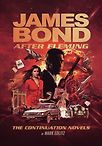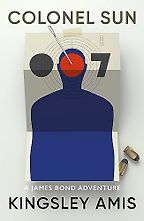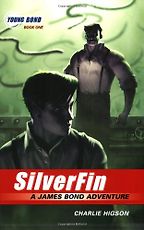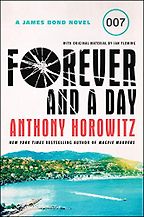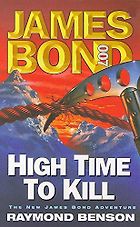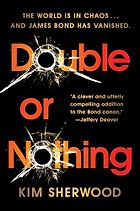You’re just written James Bond After Fleming: The Continuation Novels, a book about all the James Bond books written after Ian Fleming died. There are a lot of them—a lot more than in the original series. For people who’ve never thought about these books before, can you say how many there are and what we’re dealing with here?
Yes, so Ian Fleming died in 1964. Since that time, the Ian Fleming estate—through Ian Fleming Publications, formerly Glidrose—has published a series of James Bond novels that we have termed ‘continuation novels.’ Since Fleming’s death, there have been about 50 different Bond works. These include novels about the adult Bond, spin-offs about James Bond’s teenage years, a trilogy about Miss Moneypenny, a new series about the other agents in the Double O section, seven movie novelizations, a pseudo biography, as well as an assortment of short stories.
I’ve got used to seeing the Anthony Horowitz Bond books in bookshops—I read one a few months ago when I was on holiday. What I didn’t realize was that Kingsley Amis had written one, as well. How did that come about?
After Fleming’s death, there was a question of how Bond would continue. Fleming’s last novel, The Man with the Golden Gun was published posthumously, as was a collection of short stories. But those Fleming works would only take them so far. So the estate and his wife, Ann Fleming, had to decide how to keep Bond alive in literary form. There was also the question of whether they should even do it. Everyone said James Bond was a creation of Ian Fleming that came from his heart and soul, his attitudes, his opinions, his vices, his loves, his dislikes. So why, or how, could another author take over? Maybe they shouldn’t.
They decided that they should continue for a number of reasons. One is it protects the literary copyright. In this case, there were also other people who were not licensed who were trying to publish James Bond novels and they didn’t want that. Two, continuation novels can preserve and protect Fleming’s legacy by staying truer to Fleming’s vision of Bond than the cinematic version. So the estate picked Kingsley Amis to publish the first adult Bond novel, and I say ‘adult Bond’ because there was also a spin-off, called The Adventures of James Bond Junior 003½, about Bond’s nephew.
“In my opinion, it is Ian Fleming Publications’ goal to write Bond novels and spin-off works that are true to Ian Fleming’s literary canon and not the movies”
Amis was a Bond expert, who previously wrote The James Bond Dossier, a non-fiction scholarly work about James Bond. He had also been invited by the family to edit Fleming’s manuscript, The Man with the Golden Gun. So there was a certain level of confidence in him.
So Amis wrote the first adult James Bond novel, Colonel Sun, and on the cover of the UK edition it said ‘a James Bond adventure by Robert Markham.’ Kingsley Amis was writing under a pseudonym with the idea that he would write one book and then other authors would come in, take over, and retain the pseudonym. On the American edition of Colonel Sun, it said Kingsley Amis on the cover and, even in the UK, Amis did press. No one was trying to pretend that there really was a person named Robert Markham, but they thought that it would be neat and help organize things, if just one pseudonym was used across the board. That’s not what happened. The Markham pseudonym was retired after one novel.
Colonel Sun is important to the movie Bond in two ways. One, at the start of the book, there’s a kidnapping of M that kicks off the adventure. M was also kidnapped in the Piece Brosnan film The World Is Not Enough. There’s also a torture sequence in Colonel Sun where James Bond is pierced through his ear and through his nose with a metal object. That scene—and a few lines from that scene—were adapted into Daniel Craig’s fourth film, Spectre.
It made me laugh, reading in your book that Ann Fleming didn’t particularly like her husband writing spy novels. She thought even he should have stopped!
Yes, Ann Fleming thought he should be pursuing more high-minded literature. One thing to bear in mind is that these continuation works weren’t as common as they are today. The idea of taking one author’s work and having other people follow on is something we’re used to now, but at the time, it hadn’t really taken off.
How did you get so interested in the continuation novels?
It’s a world of Bond-dom that is not as explored as the movies, so I felt I could add value to people’s Bond bookshelves. Like many people, I had not read all of them before starting to write my book and I thought this journey would help put these novels into context for both Bond experts and casual fans of the series. I also thought James Bond After Fleming would serve as a helpful guide.
Unlike Marvel, there is no overriding story for James Bond. You can’t slip one book into each year of his career. There are different branches that James Bond takes. The best way to think of these novels is that these continuation authors are only beholden to Fleming and his 12 novels and two short story collections—they are not beholden and they do not, generally speaking, reference other continuation authors. Every once a while, there may be a little jokey reference, but that’s more of a tip of a hat to a serious Bond fan. Everything goes back to Fleming, and they wipe the slate clean each time.
So you’ve chosen five that you think are really good?
I would have preferred seven books, but that’s not what this is called. It was hard. My overriding strategy was to take the readers through the 50+ year history of post-Fleming Bond, and to pick some works from each era that would represent something that was going on.
Okay, so let’s go through the five you’ve chosen. You’ve already mentioned Colonel Sun, published in 1968. It’s by Kingsley Amis so it must be pretty well-written. Where is he picking up from?
Chronologically speaking, Colonel Sun takes place shortly after the events of The Man with the Golden Gun. Bond is still recovering from a gunshot wound that he sustained from Scaramanga. It starts with him playing golf with his best friend in the service, Bill Tanner. And unbeknownst to them, they’re being watched. When Bond goes to M’s house, he finds that he has been kidnapped. The kidnappers try to attack Bond, but he gets away. So what drives the book is Bond’s search for M, his boss, and—some would argue—his father figure.
Is Kingsley Amis able to deliver a good plot? How would you evaluate the book compared to Fleming’s own work?
What he takes from Fleming is writing about the culture. In this case, there is a heavy emphasis on Greece. The standout sequence in the book is definitely the torture that Bond goes through. Fleming had this great torture sequence in Casino Royale, where Bond is beaten in his genitals with a carpet beater. That’s always been the torture scene to beat in any Bond continuation novel.
Piercing someone through the ear is also a very effective and harrowing torture sequence. The villain, Colonel Sun, is doing it just for his own sadistic purposes. He’s not trying to extract information from Bond. He just wants to hurt him for his own pleasure and curiosity.
So part of the allure of Casino Royale is that it’s set in the south of France. Amis decides to set his book in Greece—because part of the appeal of James Bond books is the travel element?
Yes, all these books have a globetrotting nature. Fleming was a journalist. He would describe these countries and cities and foods and drinks and clothes to the reader in a way that they could experience because they themselves might not ever get to go. It really was a way to take the reader with him. That’s why a different country and a different place is important to these stories.
Let’s move on to the next book. What happened after Colonel Sun?
This is not one of the books I’m officially talking about, but I’ll briefly say that in the 1970s, there was a book called James Bond: The Authorized Biography by John Pearson. It was the story of Bond from birth all the way up to post-retirement from the service. In the book, he tells his life story to John Pearson, who knew Fleming in real life and who had written a biography of Fleming. The Authorized Biography came out in 1973 and is a curio in some ways.
But other than that book and novelizations of The Spy Who Loved Me and Moonraker, there were no new James Bond books in the 1970s. It was only in 1981 that John Gardner came along with Licence Renewed. It’s called Licence Renewed because it’s also renewing James Bond in the literary world. John Gardner went on to write 16 James Bond novels, including two novelizations. So Gardner wrote more Bond books than Ian Fleming himself.
Then, after Gardner stepped down, Raymond Benson became the first American Bond novelist. Benson was a Bond expert who also wrote a book called The James Bond Bedside Companion (1984). He was friendly with Glidrose Productions (the name of Ian Fleming’s estate at the time). They discussed various ideas and approaches with him and asked him to submit chapters to write a James Bond novel. Benson was a first-time novelist and part of the process of him taking over the reins was that he had to go through a rigorous process to ensure that he could do it.
Just before we get to Raymond Benson, given how many he wrote, I’m interested you didn’t put John Gardner in your top five. Do his books not make the cut?
No, it’s just that it’s hard to limit them to five. That’s why I wanted to mention Licence Renewed. Gardner brought Bond back into the literary world with a vengeance. His books were in the New York Times bestseller lists. And he updated Bond’s tradecraft. That’s one of the things Gardner wanted to do: update Bond’s tradecraft so that it would be relevant to that period of time. Prior to that, it’s talcum powder and little bits of hair or paper in the doors. If the door opens, they fall to the floor. Narratively, he departs from Fleming too. For instance, in Never Send Flowers, Gardner sets Bond against a serial killer.
OK so tell me about High Time To Kill.
So Benson wound up writing six James Bond novels, three novelizations, three published short stories and one un-published short story. He’s a big fan favorite and his best, arguably, is High Time to Kill.
The premise is that there’s a plane that was crashed into the top of a mountain and there’s something on it that both the heroes and the bad guys want. Who is going to win? It’s an exciting story because it’s a race. There are different parties trying to get to the top of the mountain. Bond is climbing with other people, some of whom might not wish him well. It also has that Jon Krakauer book on mountain climbing—Into Thin Air—vibe, where you’re learning about something as you go. This book is also set in the Himalayas, on Kangchenjunga, which is the third tallest mountain in the world. That was one of the things that was always so great about Ian Fleming—you always felt like you were learning something. This is a fun adventure, but you’re also learning all these facts and approaches to mountain climbing.
Where are we now?
After Raymond Benson, there’s a little bit of a pause with adult Bond books, but we do get Bond books, happily. Two different series are going on, relatively simultaneously.
One of them is The Moneypenny Diaries, a trilogy about Miss Moneypenny. The name on the book covers is Kate Westbrook, but the author is Samantha Weinberg.
The other is the Young Bond series by Charlie Higson. The idea sounds terrible. It sounds like a money grab or an ill-advised attempt to cash in on the Harry Potter craze. How do you take an adult topic, James Bond, and transform him into something that’s kid-friendly? The answer is it shouldn’t work, but it really does.
There are five books in the series and the first one is SilverFin. It takes place at Eton, where Bond is in his first year and I’d say the first two-thirds of the book are just young Bond, James, acclimating to the school. It’s a period piece. It’s set in 1933 and you’re getting this otherworldly look into the customs of this old institution during that time. I know that might not sound fascinating, but it really is. It’s enough to carry the story through and, of course, there is a mystery to be solved as young Bond gets wrapped up in his first adventure.
What Charlie Higson avoids doing is having Bond meet a young Blofeld or Jaws or whomever. Instead, his five books track the slow evolution of Bond’s character. He deals with being an orphan—Bond’s parents were killed in a climbing accident and he is sent to live with his Aunt Charmian in Pett Bottom, Canterbury. This is him dealing with that loss, and his emotional evolution. It’s great stuff.
SilverFin has a horrifying opening scene. I’m still slightly in shock. It captured some of Ian Fleming’s enjoyment of sinister creatures in the water…
There’s also a harrowing passage, as tense as anything in any Bond continuation novel, where James is swimming through a tunnel while holding his breath. He is swimming to freedom to escape the bad guy and he’s running out of breath. You feel the tension in a way that’s visceral. It’s one of the best passages in any of these books.
Let’s move on to your next choice.
We’ve now in 2008 and have reached the centenary of Ian Fleming’s birth. Ian Fleming Publications has changed their approach to the adult Bond novels. Instead of having one author do a series like Gardner or Benson, they’ve gone to very well-known authors and asked them to write one book each. So we have Sebastian Faulks with Devil May Care (2008), set in the 1960s. We have Jeffrey Deaver with Carte Blanche (2011) set in modern times. There’s also William Boyd’s Solo (2013), set in 1969. Then you have Anthony Horowitz, who was a tremendous Bond fan, write Trigger Mortis (2015). But his books were so popular—and he captured Fleming’s spirit so well—that he wound up writing three.
All three of Horowitz’s are tied closely to Fleming’s canon. Trigger Mortis is an immediate sequel to Goldfinger, taking place two weeks after the events of that story, with Bond living with Pussy Galore. The third novel, With a Mind to Kill, takes place shortly after Fleming’s last book, The Man with the Golden Gun.
I’ve chosen Forever and a Day, which takes place right before Casino Royale, the first Bond novel. It has the premise that 007 has been killed. It’s not a trick. But [SPOILER ALERT] 007 is not James Bond. He is the man who carried that code before. The newly minted Double O agent James Bond is assigned to find out what happened to his predecessor.
And it’s a good one, is it?
Yes, and it also, in its own way, helps track Bond’s emotional evolution. There’s an agent named Madame Sixtine who is a much more experienced operator than Bond and teaches him the art of lovemaking. She imprints on Bond in that and in many other ways.
There’s a wonderful moment in the book, just a paragraph or so, when they’re having dinner at home, and she asks Bond to set the table. And he thinks, ‘Oh, I don’t know the last time anybody’s asked me to set a table.’ It’s a very human moment in a character that is so mythic, just the idea of James Bond setting a table because he’s asked to and is about to have a home cooked meal.
Let’s turn to your final choice, Double or Nothing (2022) by Kim Sherwood. Is this the most recent Bond book?
Yes, we’re now up to date. We’ve had adult Bond books coming out with regularity. These 50+ works have been focused on one agent, 007. Now Ian Fleming publications have invited Kim Sherwood to write a trilogy of books, the first of which is Double or Nothing. The second, which is coming out in April, is called A Spy Like Me. These are about the next generation of Double O agents.
The concept in Double or Nothing is that James Bond is missing, presumed dead, and they have to find out what happened. For Bond enthusiasts, the idea of a James Bond novel without James Bond is anathema. But it’s not accurate to say that James Bond is absent from the book. One, he appears with some regularity in flashbacks and there are dialogue scenes with him. The other agents also all talk about him. He has a personal relationship with all these characters. So he is very present in the book, even though he’s also the MacGuffin.
He’s the thing that they’re all chasing and you get three different agents who are looking for him, including one named Johanna Harwood, who was named after the first Bond screenwriter. Now I know a lot of people say, ‘Oh, she was the first female Bond screenwriter.’ In fact, Harwood was the first Bond screenwriter full stop.
And do these next-generation agents complain about James Bond and view him as a sexist dinosaur?
They all come at Bond from different points of view and different opinions. The Harwood character and Bond had a relationship. He was the mentor to another agent. Generally, they all like him now. They’re not antagonistic towards Bond. They see him for his complexities and his faults but, for the most part, they admire him.
A final question about the Bond continuation novels. If someone has never read one and wanted to read just one, which one would you recommend? Which is your absolute favourite or is that too hard to answer?
I wouldn’t say favourite, but if the question was, ‘What would you give to someone who’s interested in exploring Bond?’ I might go with any of the Anthony Horowitz books. He is a huge student of Bond and is telling Bond stories by trying deliberately to keep true to Fleming’s spirit.
If you’re looking for a fun, action-packed book—where you’re putting the character of James Bond into an oversized movie adventure—then you might want to check out Raymond Benson. If you like a good mystery, give The Moneypenny Diaries a chance.
And in your book, James Bond After Fleming: The Continuation Novels, you cover all of them?
Yes, my book is an overview of all the James Bond books written after Ian Fleming’s death. It’s meant to guide the reader through all the books and help them select something that will be for their tastes, as well as providing an overview of the literary history of Bond. There is also original art by Pat Carbajal that depicts keys scenes from the novels.
Each book gets its own chapter. That includes a summary of what happens in the book and commentary about what the author is trying to accomplish. Different books serve different functions. So I try to help the reader make sense of all of it. James Bond After Fleming also explores how each continuation novel approaches Bond’s character and has added to Bond’s personal history, his mission history, his tastes, attitudes, thinking, work life, adventures, and work methods. It also tells you how Bond has requested his eggs in each book. You can’t be left without knowing Bond’s egg order, I think.
James Bond After Fleming is the first book dedicated to the Bond continuation novels. I was surprised that no one had written this kind of book before. So, I gave it a go. I hope readers find it to be a useful reference book and resource.
You also bring in the movies, don’t you?
Yes, you can’t escape them. The general public doesn’t separate the books from the movies. One thing I will say is that, in my opinion, it is Ian Fleming Publications’ goal to write Bond novels and spin-off works that are true to Ian Fleming’s literary canon and not the movies. It’s hard for the authors to separate them, but the goal—to the extent that they can—is to ignore the movies and be true to Fleming.
Yes, because in Ian Fleming’s books not much happens most of the time, which is what I like about them. The pace is slow.
These novels are much more twisty and turn-y than Fleming’s originals.
And if somebody is interested in Ian Fleming what should they read?
For a biography of Ian Fleming, I would go for the new one, by Nicholas Shakespeare. There’s also a collection of Ian Fleming’s letters, The Man with the Golden Typewriter, edited by his nephew, Fergus Fleming. For the Bond books by Fleming, go with the first one, Casino Royale.
Five Books aims to keep its book recommendations and interviews up to date. If you are the interviewee and would like to update your choice of books (or even just what you say about them) please email us at [email protected]
Five Books interviews are expensive to produce. If you've enjoyed this interview, please support us by donating a small amount.

